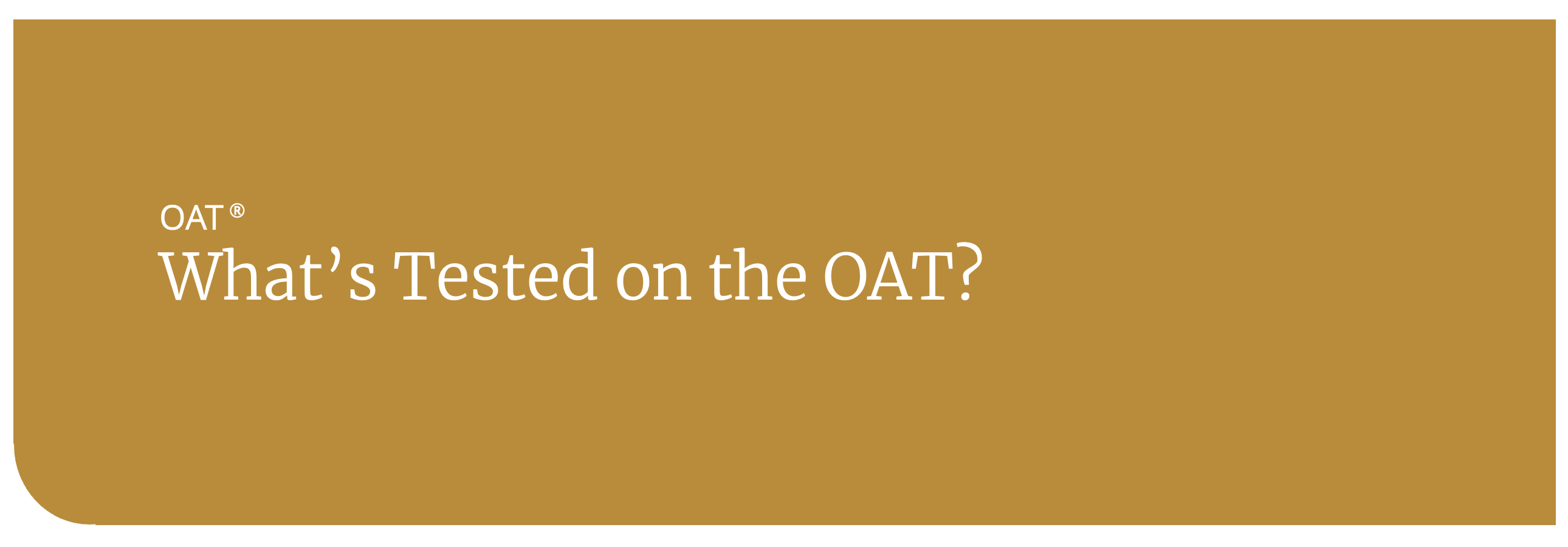What's Tested on the OAT
All schools and colleges of optometry require candidates to submit OAT scores for admissions. The OAT is designed to predict general academic ability and measure the two skills needed by future optometrists: scientific knowledge and analytical ability.
The OAT consists of four timed sections:
- The Survey of Natural Sciences (including Biology, General Chemistry, and Organic Chemistry), which tests your knowledge and application of university-level sciences.
- Reading Comprehension, which tests your ability to comprehend, analyze, and interpret reading passages on scientific topics.
- Physics, which tests your knowledge of Units and Vectors, Linear Kinematics, Statics, Dynamics, Rotational Motion, Energy and Momentum, Simple Harmonic Motion, Waves, Fluid Statics, Thermal Energy and Thermodynamics, Electrostatics, D.C. Circuits, and Optics.
- Quantitative Reasoning, which tests your knowledge of Algebra (equations and expressions, inequalities, exponential notation, absolute value, ratios and proportions, and graphical analysis); Data Analysis, Interpretation, and Sufficiency; Quantitative Comparison; and Probability and Statistics.
Keep reading to learn more about what’s tested on the OAT.
OAT Survey of Natural Sciences
In the OAT Survey of Natural Sciences, you’ll have 90 minutes to answer 40 questions on Biology, 30 questions on General Chemistry, and 30 questions on Organic Chemistry for a total of 100 stand-alone, multiple-choice questions.
Essentially you have a little under a minute per question (52 seconds to be exact). The key to remember is that some questions require more time whereas others don’t take as much time. Begin with your strengths and answer all the questions that you are comfortable with. Mark the tough ones and come back to them at the end.
[ GOOD TO KNOW: Create an OAT study schedule ]
OAT Reading Comprehension
On the Reading Comprehension section of the OAT, you’ll have 60 minutes to do three passages, each of which has 16-17 questions for a total of 50 questions. This section tests your ability to find the main idea, process information, and read and understand dense passages.
Allow yourself approximately 20 minutes per passage. It may seem like a lot of time, but it goes by very quickly. Do the easiest passages first. Within a section, if you’re deciding which passage to do based on time alone, do the one with the most questions. That way you maximize your reading efficiency. However keep in mind that some passages are longer than others. On average, give yourself about 8 to 9 minutes to read and then 10 to 11 minutes for the questions.
OAT Physics
On the Physics section of the OAT, you’ll have 50 minutes to answer 40 stand-alone, multiple-choice questions. Tested topics include vectors, energy and momentum, thermodynamics, magnetism, and optics.
The same strategy that is useful in the Natural Sciences applies here. Go with your strengths and answer the questions that are easiest for you. Mark the tough questions so you can come back to them at the end.
This is what an OAT physics questions might look like.
OAT Quantitative Reasoning
The Quantitative Reasoning section tests your proficiency in mathematics and assesses your problem-solving skills. The questions you encounter on this section range from simple arithmetic to more advanced trigonometric problems.
To succeed on Quantitative Reasoning, you need to understand basic mathematical concepts and show proficiency in algebra, geometry, trigonometry, and word problems. On the test you’ll have 45 minutes to answer 40 questions—any of which could draw from these topics.
This is what an OAT quantitative reasoning question might look like.
Two types of questions you’ll see on the OAT Quantitative Reasoning section are Quantitative Comparisons and Data Sufficiency.
OAT Scoring
The OAT is given a scaled score of 200-400, 300 being the median representing the 50th percentile. Separate subscores are reported for biology, general chemistry, organic chemistry, reading comprehension, physics, and quantitative reasoning.
Each question within a section is worth the same amount, and there’s no penalty for guessing. That means you should always answer every question. Never let time run out on any section without selecting an answer choice for every question.
Your score report will tell you (and optometry schools) not only your scaled scores but also your percentile ranking. Students often ask: what’s a good score? Much depends on the strength of the rest of your application (if your transcript is first-rate, the pressure to strut your stuff on the OAT isn’t as intense) and on where you want to go to school (different schools have different score expectations).
[ KEEP STUDYING: What’s a good OAT score? ]


